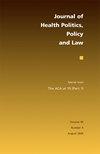Challenges with Defining Pharmaceutical Markets and Potential Remedies to Screen for Industry Consolidation.
IF 3.3
3区 医学
Q1 HEALTH CARE SCIENCES & SERVICES
引用次数: 0
Abstract
CONTEXT Dramatic increases in pharmaceutical merger and acquisition activity since 2010 suggest we are currently in the midst of a third wave of industry consolidation. METHODS Reviewing 168 economic, legal, medical, industry, and government sources, we examine the effects of consolidation on competition and innovation and explore how industry attributes complicate M&A regulation in a pharmaceutical context. FINDINGS We find that, in spite of certain metrics that might argue otherwise, consolidation consistently reduces innovation and harms the public good. We also find that several factors within the pharmaceutical industry impede proper evaluation of proposed mergers. Because consumer choice across substitutes is limited, pharmaceutical markets frustrate conventional methods of defining markets. Volume bargaining in the pharmaceutical supply chain and common ownership of pharmaceutical firms by asset managers further complicate the definitional process. Hence, the Herfindahl-Hirschman Index (HHI), one measure used by the Federal Trade Commission and Department of Justice to screen for concerning M&A activity, sometimes depends on faulty market definitions but also fails to capture the implications of consolidation on future market share. CONCLUSIONS We describe ways to improve how pharmaceutical markets are defined, highlight quantitative alterations to HHI to account for common ownership, and propose areas requiring further research.定义药品市场的挑战和筛选行业整合的潜在补救措施。
自2010年以来,制药行业并购活动的急剧增加表明,我们目前正处于第三波行业整合浪潮中。方法回顾了168个经济、法律、医疗、行业和政府来源,我们考察了整合对竞争和创新的影响,并探讨了行业属性如何使制药环境下的并购监管复杂化。我们发现,尽管某些指标可能会反驳,但整合始终会减少创新并损害公共利益。我们还发现,制药行业内部的几个因素阻碍了对拟议合并的适当评估。由于消费者在替代品之间的选择是有限的,药品市场挫败了传统的定义市场的方法。药品供应链中的批量议价和资产管理公司对制药公司的共同所有权进一步使定义过程复杂化。因此,赫芬达尔-赫希曼指数(HHI)——美国联邦贸易委员会和司法部用来筛选并购活动的一种指标——有时依赖于错误的市场定义,但也未能捕捉到整合对未来市场份额的影响。我们描述了改进药品市场定义的方法,强调了HHI的定量变化以解释共同所有权,并提出了需要进一步研究的领域。
本文章由计算机程序翻译,如有差异,请以英文原文为准。
求助全文
约1分钟内获得全文
求助全文
来源期刊
CiteScore
7.30
自引率
7.10%
发文量
46
审稿时长
>12 weeks
期刊介绍:
A leading journal in its field, and the primary source of communication across the many disciplines it serves, the Journal of Health Politics, Policy and Law focuses on the initiation, formulation, and implementation of health policy and analyzes the relations between government and health—past, present, and future.

 求助内容:
求助内容: 应助结果提醒方式:
应助结果提醒方式:


